child lock HONDA CIVIC COUPE 2017 10.G Owners Manual
[x] Cancel search | Manufacturer: HONDA, Model Year: 2017, Model line: CIVIC COUPE, Model: HONDA CIVIC COUPE 2017 10.GPages: 595
Page 4 of 595
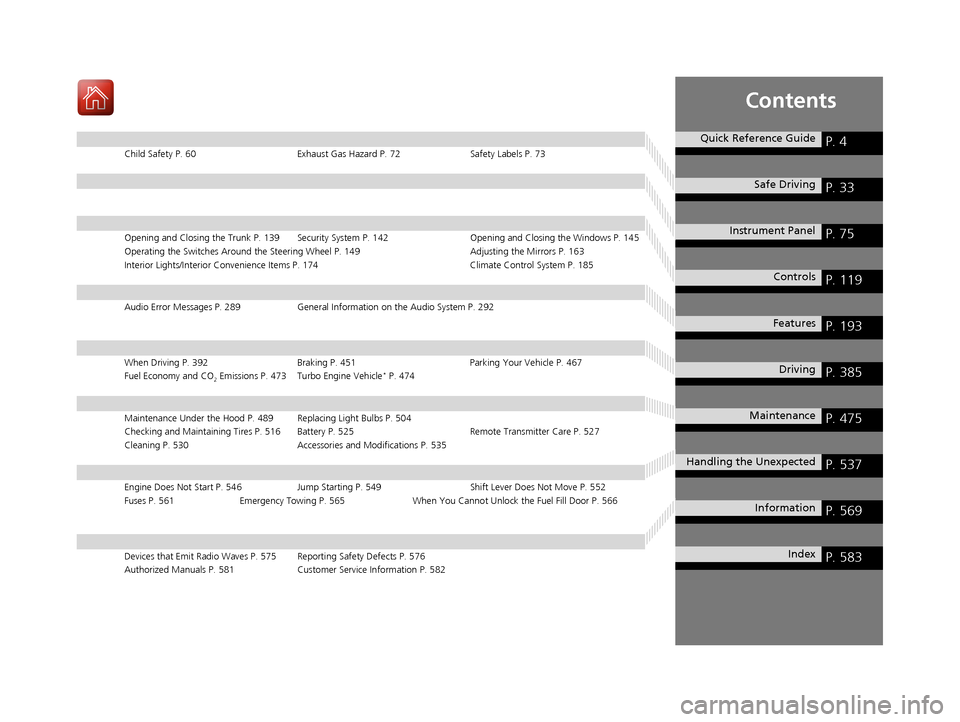
Contents
Child Safety P. 60Exhaust Gas Hazard P. 72Safety Labels P. 73
Opening and Closing the Trunk P. 139 Security System P. 142 Opening and Closing the Windows P. 145
Operating the Switches Around the Steering Wheel P. 149 Adjusting the Mirrors P. 163
Interior Lights/Interior Convenience Items P. 174 Climate Control System P. 185
Audio Error Messages P. 289General Information on the Audio System P. 292
When Driving P. 392 Braking P. 451Parking Your Vehicle P. 467
Fuel Economy and CO
2 Emissions P. 473 Turbo Engine Vehicle* P. 474
Maintenance Under the Hood P. 489 Replacing Light Bulbs P. 504
Checking and Maintaining Tires P. 516 Battery P. 525 Remote Transmitter Care P. 527
Cleaning P. 530 Accessories and Modifications P. 535
Engine Does Not Start P. 546 Jump Starting P. 549 Shift Lever Does Not Move P. 552
Fuses P. 561 Emergency Towing P. 565 When You Cannot Unlock the Fuel Fill Door P. 566
Devices that Emit Radio Waves P. 575 Reporting Safety Defects P. 576
Authorized Manuals P. 581 Customer Service Information P. 582
Quick Reference GuideP. 4
Safe DrivingP. 33
Instrument PanelP. 75
ControlsP. 119
FeaturesP. 193
DrivingP. 385
MaintenanceP. 475
Handling the UnexpectedP. 537
InformationP. 569
IndexP. 583
17 CIVIC 2D HCM (KA KC KL)-31TBG6100.book 3 ページ 2016年8月31日 水曜日 午後5時43分
Page 38 of 595
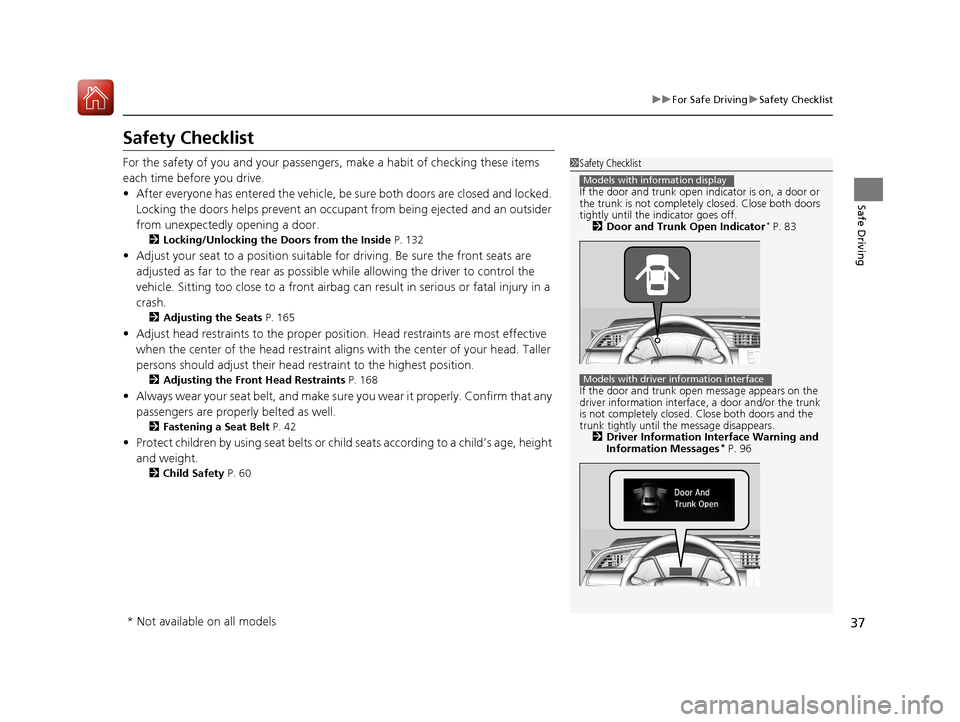
37
uuFor Safe Driving uSafety Checklist
Safe Driving
Safety Checklist
For the safety of you and your passengers, make a habit of checking these items
each time before you drive.
• After everyone has entered the vehicle, be sure both doors are closed and locked.
Locking the doors helps prevent an occupant from being ejected and an outsider
from unexpectedly opening a door.
2 Locking/Unlocking the Doors from the Inside P. 132
•Adjust your seat to a position suitable for driving. Be sure the front seats are
adjusted as far to the rear as possible while allowing the driver to control the
vehicle. Sitting too close to a front airbag can result in serious or fatal injury in a
crash.
2 Adjusting the Seats P. 165
•Adjust head restraints to the proper position. Head restraints are most effective
when the center of the head restraint aligns with the center of your head. Taller
persons should adjust their head restraint to the highest position.
2 Adjusting the Front Head Restraints P. 168
•Always wear your seat belt, and make sure you wear it properly. Confirm that any
passengers are properly belted as well.
2 Fastening a Seat Belt P. 42
•Protect children by using seat belts or chil d seats according to a child’s age, height
and weight.
2 Child Safety P. 60
1Safety Checklist
If the door and trunk open indicator is on, a door or
the trunk is not completely closed. Close both doors
tightly until the indicator goes off. 2 Door and Trunk Open Indicator
* P. 83
If the door and trunk open message appears on the
driver information interface , a door and/or the trunk
is not completely closed. Close both doors and the
trunk tightly until the message disappears. 2 Driver Information Interface Warning and
Information Messages
* P. 96
Models with information display
Models with driver information interface
* Not available on all models
17 CIVIC 2D HCM (KA KC KL)-31TBG6100.book 37 ページ 2016年8月31日 水曜日 午後5時43分
Page 39 of 595
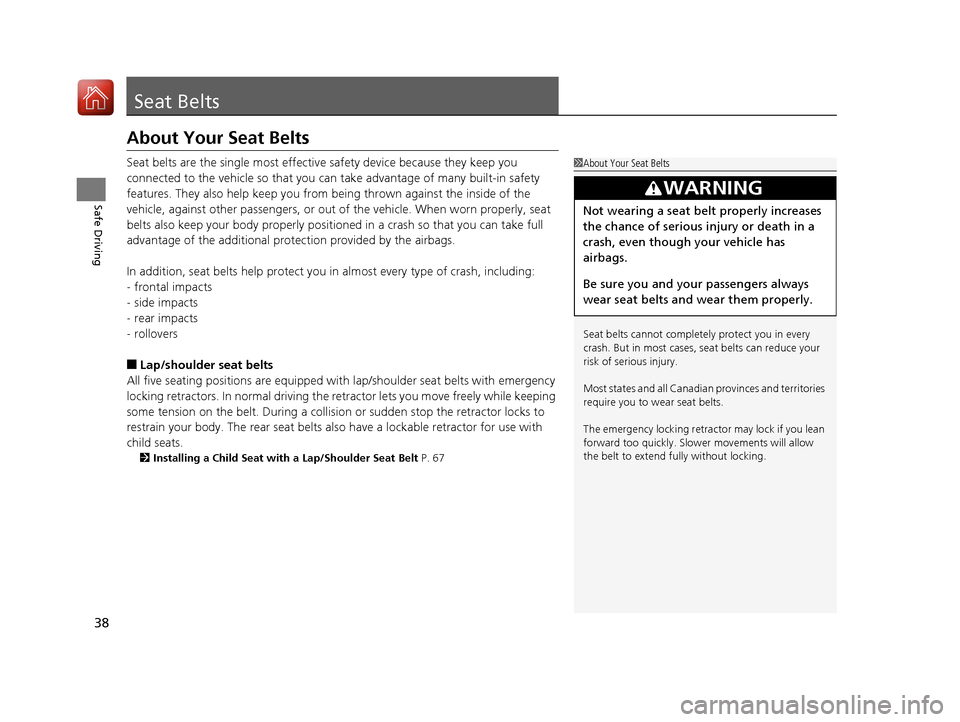
38
Safe Driving
Seat Belts
About Your Seat Belts
Seat belts are the single most effective safety device because they keep you
connected to the vehicle so that you can take advantage of many built-in safety
features. They also help keep you from be ing thrown against the inside of the
vehicle, against other passengers, or out of the vehicle. When worn properly, seat
belts also keep your body pr operly positioned in a crash so that you can take full
advantage of the additional protec tion provided by the airbags.
In addition, seat belts help protect you in almost every type of crash, including:
- frontal impacts
- side impacts
- rear impacts
- rollovers
■Lap/shoulder seat belts
All five seating positions are equipped with lap/shoulder seat belts with emergency
locking retractors. In normal driving the re tractor lets you move freely while keeping
some tension on the belt. During a collision or sudden stop the retractor locks to
restrain your body. The rear seat belts al so have a lockable retractor for use with
child seats.
2 Installing a Child Seat with a Lap/Shoulder Seat Belt P. 67
1About Your Seat Belts
Seat belts cannot complete ly protect you in every
crash. But in most cases, seat belts can reduce your
risk of serious injury.
Most states and all Canadian provinces and territories
require you to w ear seat belts.
The emergency locking retrac tor may lock if you lean
forward too quickly. Slower movements will allow
the belt to extend fu lly without locking.
3WARNING
Not wearing a seat belt properly increases
the chance of serious injury or death in a
crash, even though your vehicle has
airbags.
Be sure you and your passengers always
wear seat belts and wear them properly.
17 CIVIC 2D HCM (KA KC KL)-31TBG6100.book 38 ページ 2016年8月31日 水曜日 午後5時43分
Page 62 of 595
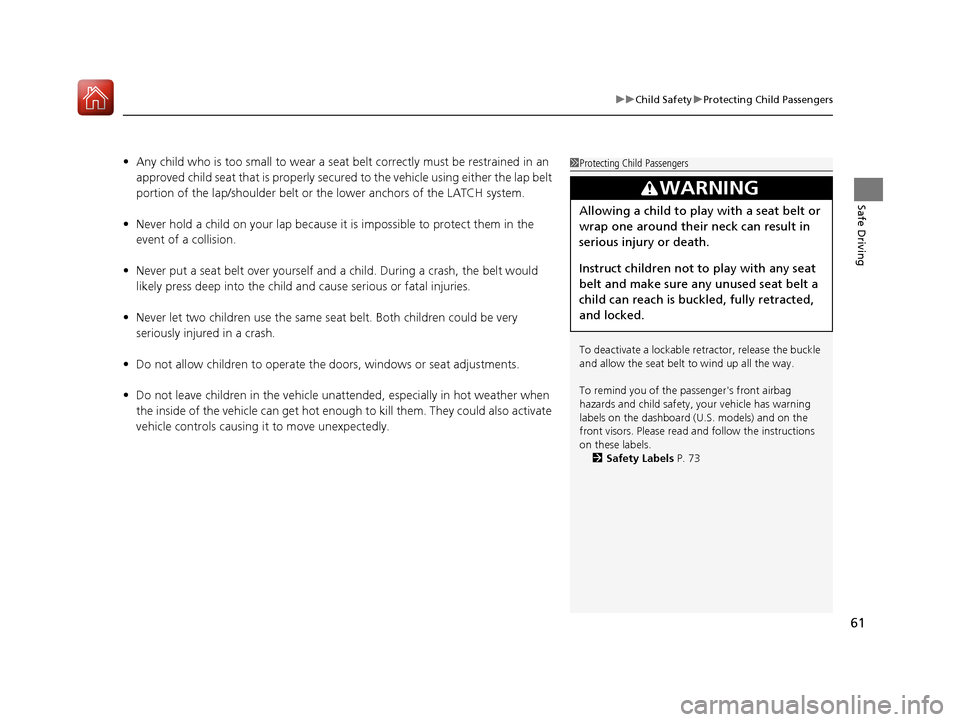
61
uuChild Safety uProtecting Child Passengers
Safe Driving
• Any child who is too small to wear a seat belt correctly must be restrained in an
approved child seat that is properly secured to the vehicle using either the lap belt
portion of the lap/shoulder belt or the lower anchors of the LATCH system.
• Never hold a child on your lap because it is impossible to protect them in the
event of a collision.
• Never put a seat belt over yourself and a child. During a crash, the belt would
likely press deep into the child and cause serious or fatal injuries.
• Never let two children use the same seat belt. Both children could be very
seriously injured in a crash.
• Do not allow children to operate the doors, windows or seat adjustments.
• Do not leave children in the vehicle unattended, especially in hot weather when
the inside of the vehicle can get hot enough to kill them. They could also activate
vehicle controls causing it to move unexpectedly.1Protecting Child Passengers
To deactivate a lockable retractor, release the buckle
and allow the seat belt to wind up all the way.
To remind you of the pa ssenger's front airbag
hazards and child safety, your vehicle has warning
labels on the dashboard (U.S. models) and on the
front visors. Please read and follow the instructions
on these labels. 2 Safety Labels P. 73
3WARNING
Allowing a child to play with a seat belt or
wrap one around their neck can result in
serious injury or death.
Instruct children not to play with any seat
belt and make sure any unused seat belt a
child can reach is buckled, fully retracted,
and locked.
17 CIVIC 2D HCM (KA KC KL)-31TBG6100.book 61 ページ 2016年8月31日 水曜日 午後5時43分
Page 63 of 595
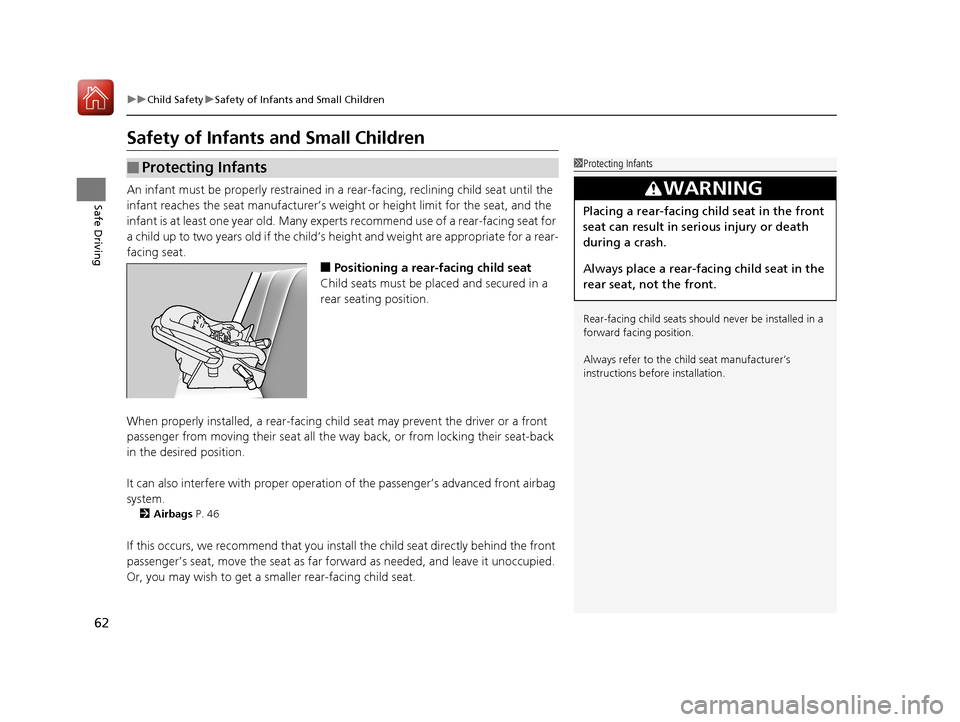
62
uuChild Safety uSafety of Infants and Small Children
Safe Driving
Safety of Infants and Small Children
An infant must be properly restrained in a rear-facing, reclining child seat until the
infant reaches the seat manufacturer’s weig ht or height limit for the seat, and the
infant is at least one year old. Many expe rts recommend use of a rear-facing seat for
a child up to two years old if the child’s he ight and weight are appropriate for a rear-
facing seat.
■Positioning a rear-facing child seat
Child seats must be placed and secured in a
rear seating position.
When properly installed, a rear-facing child seat may prevent the driver or a front
passenger from moving their seat all the way back, or from locking their seat-back
in the desired position.
It can also interfere with pr oper operation of the passenger’s advanced front airbag
system.
2 Airbags P. 46
If this occurs, we recommend that you install the child seat directly behind the front
passenger’s seat, move the seat as far fo rward as needed, and leave it unoccupied.
Or, you may wish to get a sm aller rear-facing child seat.
■Protecting Infants1Protecting Infants
Rear-facing child seats should never be installed in a
forward facing position.
Always refer to the child seat manufacturer’s
instructions before installation.
3WARNING
Placing a rear-facing child seat in the front
seat can result in serious injury or death
during a crash.
Always place a rear-fac ing child seat in the
rear seat, not the front.
17 CIVIC 2D HCM (KA KC KL)-31TBG6100.book 62 ページ 2016年8月31日 水曜日 午後5時43分
Page 67 of 595
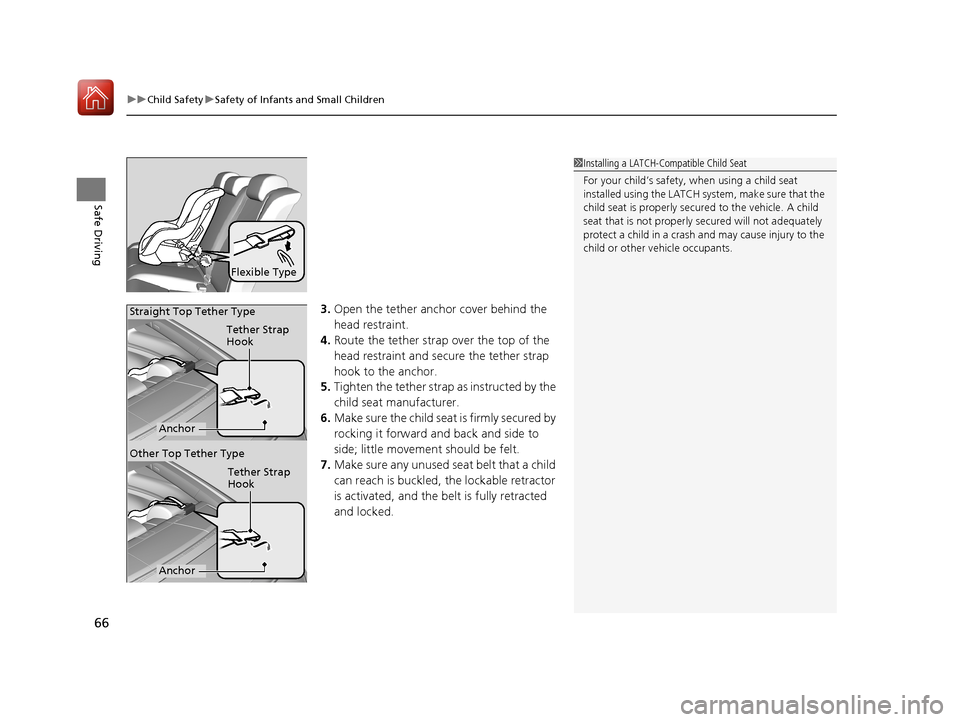
uuChild Safety uSafety of Infants and Small Children
66
Safe Driving
3. Open the tether anchor cover behind the
head restraint.
4. Route the tether strap over the top of the
head restraint and secure the tether strap
hook to the anchor.
5. Tighten the tether strap as instructed by the
child seat manufacturer.
6. Make sure the child seat is firmly secured by
rocking it forward and back and side to
side; little movement should be felt.
7. Make sure any unused seat belt that a child
can reach is buckled, the lockable retractor
is activated, and the be lt is fully retracted
and locked.
Flexible Type
1 Installing a LATCH-Compatible Child Seat
For your child’s safety, when using a child seat
installed using the LATCH system, make sure that the
child seat is properly secured to the vehicle. A child
seat that is not properly secured will not adequately
protect a child in a crash and may cause injury to the
child or other vehicle occupants.
Tether Strap
Hook
Anchor
Straight Top Tether Type
Tether Strap
Hook
Anchor
Other Top Tether Type
17 CIVIC 2D HCM (KA KC KL)-31TBG6100.book 66 ページ 2016年8月31日 水曜日 午後5時43分
Page 68 of 595
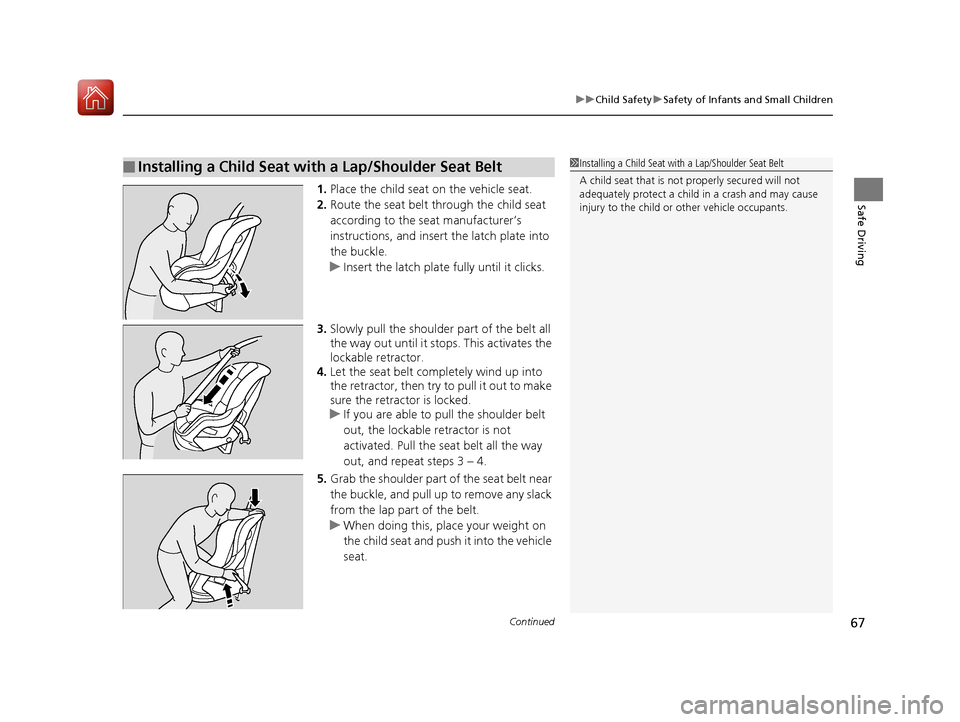
Continued67
uuChild Safety uSafety of Infants and Small Children
Safe Driving1. Place the child seat on the vehicle seat.
2. Route the seat belt through the child seat
according to the seat manufacturer’s
instructions, and insert the latch plate into
the buckle.
u Insert the latch plate fully until it clicks.
3. Slowly pull the shoulder part of the belt all
the way out until it stops. This activates the
lockable retractor.
4. Let the seat belt completely wind up into
the retractor, then try to pull it out to make
sure the retractor is locked.
u If you are able to pull the shoulder belt
out, the lockable retractor is not
activated. Pull the seat belt all the way
out, and repeat steps 3 – 4.
5. Grab the shoulder part of the seat belt near
the buckle, and pull up to remove any slack
from the lap part of the belt.
u When doing this, place your weight on
the child seat and push it into the vehicle
seat.
■Installing a Child Seat with a Lap/Shoulder Seat Belt1Installing a Child Seat with a Lap/Shoulder Seat Belt
A child seat that is not properly secured will not
adequately protect a child in a crash and may cause
injury to the child or other vehicle occupants.
17 CIVIC 2D HCM (KA KC KL)-31TBG6100.book 67 ページ 2016年8月31日 水曜日 午後5時43分
Page 69 of 595
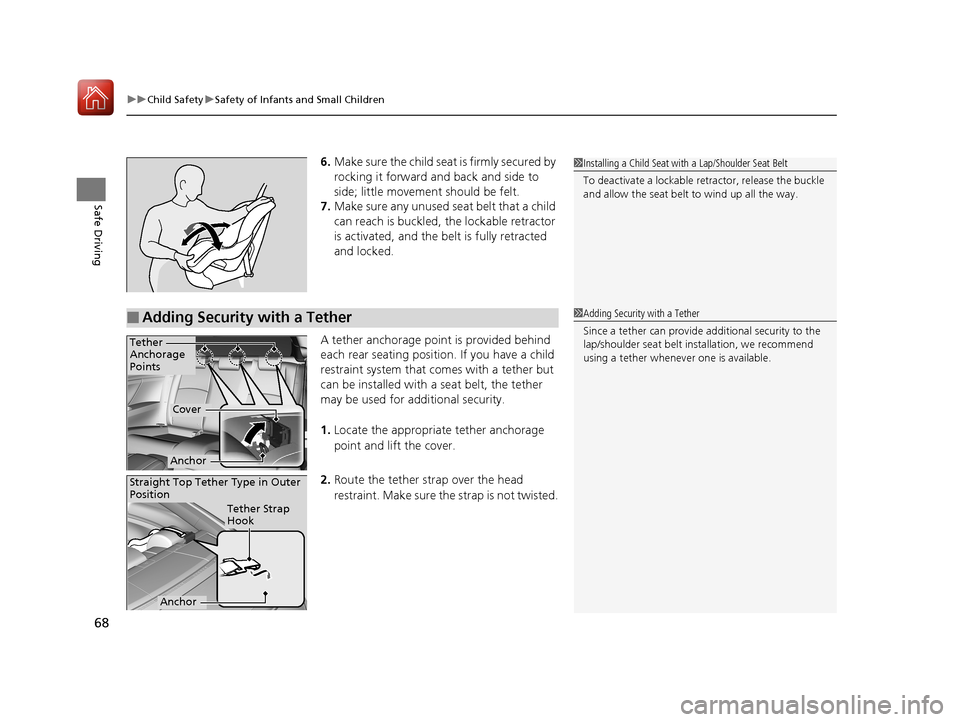
uuChild Safety uSafety of Infants and Small Children
68
Safe Driving
6. Make sure the child seat is firmly secured by
rocking it forward and back and side to
side; little movement should be felt.
7. Make sure any unused seat belt that a child
can reach is buckled, the lockable retractor
is activated, and the be lt is fully retracted
and locked.
A tether anchorage point is provided behind
each rear seating position. If you have a child
restraint system that comes with a tether but
can be installed with a seat belt, the tether
may be used for additional security.
1. Locate the appropriate tether anchorage
point and lift the cover.
2. Route the tether strap over the head
restraint. Make sure the strap is not twisted.1Installing a Child Seat with a Lap/Shoulder Seat Belt
To deactivate a lockable retractor, release the buckle
and allow the seat belt to wind up all the way.
■Adding Security with a Tether1 Adding Security with a Tether
Since a tether can provide additional security to the
lap/shoulder seat belt in stallation, we recommend
using a tether whenever one is available.
Tether
Anchorage
Points
Cover
Anchor
Straight Top Tether Type in Outer
Position
Tether Strap
Hook
Anchor
17 CIVIC 2D HCM (KA KC KL)-31TBG6100.book 68 ページ 2016年8月31日 水曜日 午後5時43分
Page 146 of 595
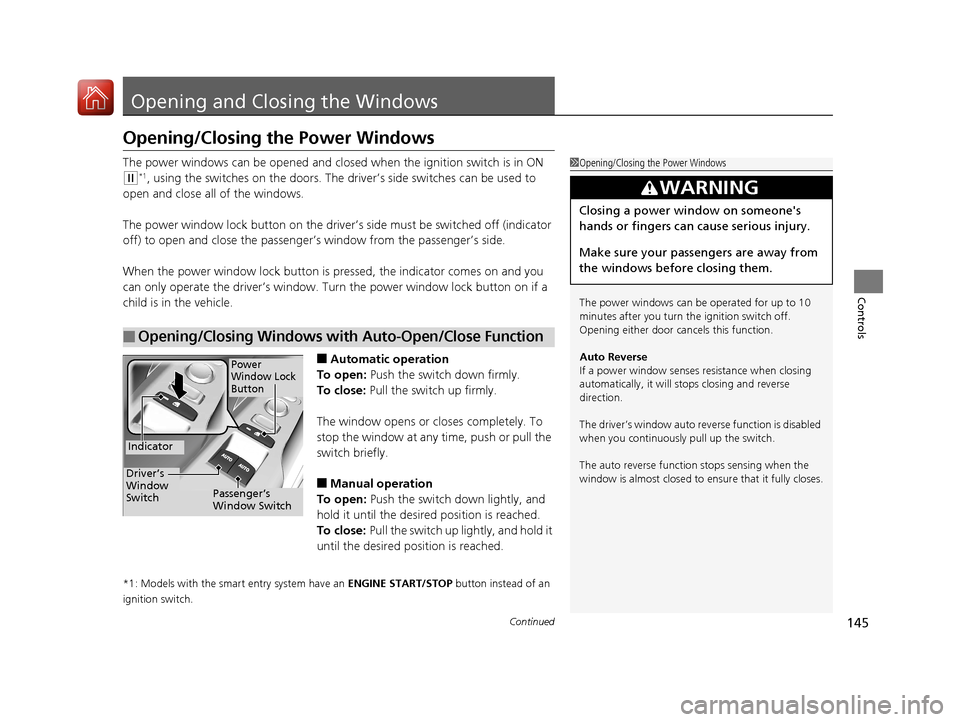
145Continued
Controls
Opening and Closing the Windows
Opening/Closing the Power Windows
The power windows can be opened and clos ed when the ignition switch is in ON
(w*1, using the switches on the doors. The driver’s side switches can be used to
open and close all of the windows.
The power window lock button on the driver’s side must be switched off (indicator
off) to open and close the passenger’ s window from the passenger’s side.
When the power window lock button is pressed, the indicator comes on and you
can only operate the driver’s window. Turn the power window lock button on if a
child is in the vehicle.
■Automatic operation
To open: Push the switch down firmly.
To close: Pull the switch up firmly.
The window opens or closes completely. To
stop the window at any time, push or pull the
switch briefly.
■Manual operation
To open: Push the switch down lightly, and
hold it until the desired position is reached.
To close: Pull the switch up lightly, and hold it
until the desired position is reached.
*1: Models with the smart entry system have an ENGINE START/STOP button instead of an
ignition switch.
■Opening/Closing Windows with Auto-Open/Close Function
1 Opening/Closing the Power Windows
The power windows can be operated for up to 10
minutes after you turn the ignition switch off.
Opening either door cancels this function.
Auto Reverse
If a power window senses resistance when closing
automatically, it will st ops closing and reverse
direction.
The driver’s window auto re verse function is disabled
when you continuously pull up the switch.
The auto reverse function stops sensing when the
window is almost closed to en sure that it fully closes.
3WARNING
Closing a power window on someone's
hands or fingers can cause serious injury.
Make sure your passengers are away from
the windows before closing them.
Power
Window Lock
Button
Indicator
Driver’s
Window
Switch
Passenger’s
Window Switch
17 CIVIC 2D HCM (KA KC KL)-31TBG6100.book 145 ページ 2016年8月31日 水曜日 午後5時43分
Page 585 of 595
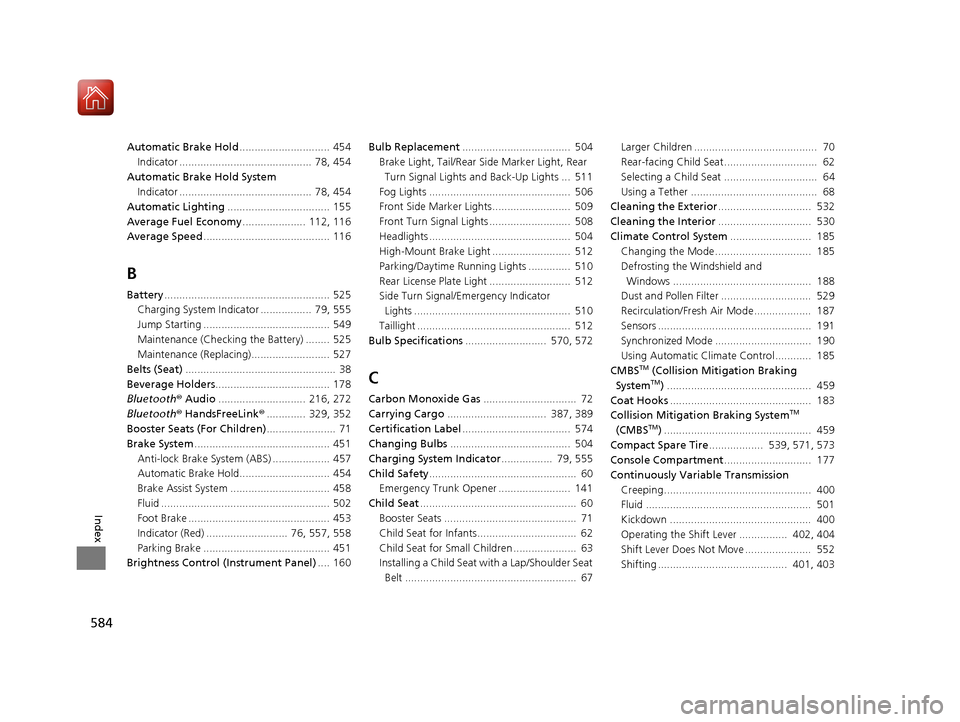
584
Index
Automatic Brake Hold.............................. 454
Indicator ............................................ 78, 454
Automatic Brake Hold System Indicator ............................................ 78, 454
Automatic Lighting .................................. 155
Average Fuel Economy ..................... 112, 116
Average Speed .......................................... 116
B
Battery....................................................... 525
Charging System Indicator ................. 79, 555
Jump Starting .......................................... 549
Maintenance (Checking the Battery) ........ 525
Maintenance (Replacing).......................... 527
Belts (Seat) .................................................. 38
Beverage Holders ...................................... 178
Bluetooth ® Audio ............................. 216, 272
Bluetooth ® HandsFreeLink ®............. 329, 352
Booster Seats (For Children) ....................... 71
Brake System ............................................. 451
Anti-lock Brake System (ABS) ................... 457
Automatic Brake Hold.............................. 454
Brake Assist System ................................. 458
Fluid ........................................................ 502
Foot Brake ............................................... 453
Indicator (Red) ........................... 76, 557, 558
Parking Brake .......................................... 451
Brightness Control (Instrument Panel) .... 160Bulb Replacement
.................................... 504
Brake Light, Tail/Rear Side Marker Light, Rear
Turn Signal Lights and Back-Up Lights ... 511
Fog Lights ............................................... 506
Front Side Marker Lights.......................... 509
Front Turn Signal Lights ........................... 508
Headlights ............................................... 504
High-Mount Brake Light .......................... 512
Parking/Daytime Running Lights .............. 510
Rear License Plate Light ........................... 512
Side Turn Signal/Emergency Indicator
Lights .................................................... 510
Taillight ................................................... 512
Bulb Specifications ........................... 570, 572
C
Carbon Monoxide Gas ............................... 72
Carrying Cargo ................................. 387, 389
Certification Label .................................... 574
Changing Bulbs ........................................ 504
Charging System Indicator ................. 79, 555
Child Safety ................................................. 60
Emergency Trunk Opener ........................ 141
Child Seat .................................................... 60
Booster Seats ............................................ 71
Child Seat for Infants................................. 62
Child Seat for Small Children ..................... 63
Installing a Child Seat wi th a Lap/Shoulder Seat
Belt ......................................................... 67 Larger Children ......................................... 70
Rear-facing Child Seat............................... 62
Selecting a Child Seat ............................... 64
Using a Tether .......................................... 68
Cleaning the Exterior ............................... 532
Cleaning the Interior ............................... 530
Climate Control System ........................... 185
Changing the Mode................................ 185
Defrosting the Windshield and Windows .............................................. 188
Dust and Pollen Filter .............................. 529
Recirculation/Fresh Air Mode................... 187
Sensors ................................................... 191
Synchronized Mode ................................ 190
Using Automatic Climate Control............ 185
CMBS
TM (Collision Mitigation Braking
SystemTM) ................................................ 459
Coat Hooks ............................................... 183
Collision Mitigation Braking System
TM
(CMBSTM) ................................................. 459
Compact Spare Tire .................. 539, 571, 573
Console Compartment ............................. 177
Continuously Variable Transmission Creeping................................................. 400
Fluid ....................................................... 501
Kickdown ............................................... 400
Operating the Shift Lever ................ 402, 404
Shift Lever Does Not Move ...................... 552
Shifting ........................................... 401, 403
17 CIVIC 2D HCM (KA KC KL)-31TBG6100.book 584 ページ 2016年8月31日 水曜日 午後5時43分